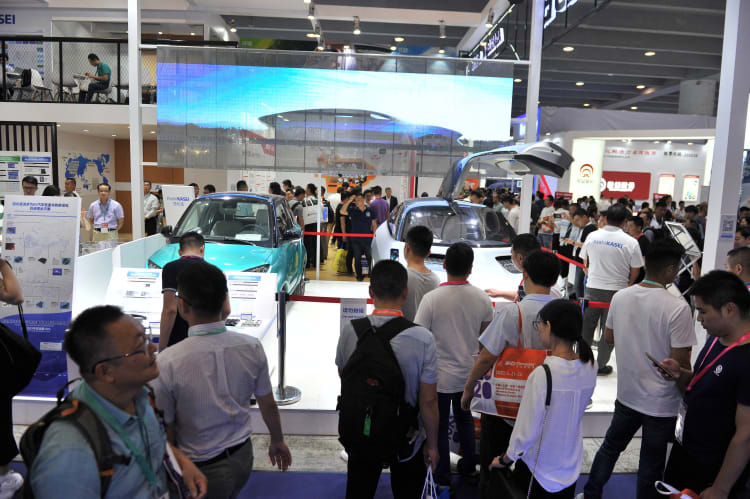Race to zero-emissions in the growing EV markets
In the ASEAN, the growing momentum to reduce carbon emissions in the environment is setting the stage for the 650 million consumers in the region to switch to green technologies.
Asia represented 16% of the world's total transportation emissions in 2006. By 2030, its share of vehicle-related carbon emissions is expected to rise to 31%. For this reason, the adoption of electric vehicles (EVs), including hybrid electric vehicles (HEVs), touted to generate zero emissions, is being promoted to reduce the carbon impact of the transport sector.

Electric vehicles were attracting much attention at Chinaplas.
In Southeast Asia, the manufacture of EVs is gaining traction. Indonesia, the second largest car producer in the region after Thailand, plans to begin producing EVs in 2022. By 2025, EVs and HEVs will make up 20% of total vehicle production in Indonesia, with the country having good prospects of becoming a regional EV manufacturing centre by 2030.
Thailand, the biggest car manufacturer in Southeast Asia, is also expanding its EV industry. The Thailand government has established the National Electric Vehicle Policy Committee (NEVPC) that oversees the national EV roadmap targeting to produce 1.2 million EVs by 2035. The country’s BOI has also offered tax incentives for EV/HEV projects such as tax holidays for manufacturers and businesses in the EV supply chain, including producers of battery modules and cells.
Vietnam is also making inroads in its EV production with the launch of three locally produced smart battery-electric SUVs in January 2021, which are expected to debut in the US market in 2022. The country, which posted a 7% drop in total vehicle sales in 2020 against the previous year's sales, is charging ahead in its EV production plan - in a bid to mitigate its rising pollution levels.
Packaging demands for sustainability: a constant feature
The rising opportunity in the food delivery sector and home delivery of consumer goods has presented growth opportunities for the packaging sector. A Transparency Market Research report on the ASEAN packaging industry noted a high demand in the flexible packaging market in Indonesia, particularly in the bags, pouches and films segments. Meanwhile, the current increase in online shopping and home delivery activities has not only led to a demand for packaging but has also changed consumer preferences for packaging.
A Euromonitor report examined the impact of Covid-19 on the Malaysian packaging industries and concluded that revenues were hit by the decline in consumer spending. In Malaysia, containment measures limited economic activities leading to below-normal purchases of packaged retail goods. On another note, consumer preferences may change in post-pandemic years. For instance, labelling and convenient packaging formats, or packaging with closures or an easy-to-open design for consumption on the go, were some of the important features favored by consumers, according to Euromonitor.
In the Philippines, the packaging market is projected to grow 3.3% to 69 billion units annually by 2024, according to GlobalData. The growth is mainly driven by the rigid packaging segment, estimated to present a CAGR of 6.4% between 2019 and 2024. Boosting demand for rigid packaging is the popularity of packaged and processed foods and soft drinks portable containers.
In Vietnam, online shopping and home delivery during the Covid-19 lockdown have promoted the preference for larger packs and multipacks to prioritize safety. GlobalData forecasted Vietnam’s e-commerce activity had surged by 30.3% to US$13.1 billion during 2020. Relatedly, Vietnam is due to ban single-use plastics from convenience stores and supermarkets by 2021. This move, along with the ban on imported scraps by 2025, is aimed at increasing recycling rates of municipal waste to 90%.
As a result, the industry is seeking continued development of recyclable materials and sustainable technologies that can enable manufacturers to use fewer plastics without compromising the quality of the packaged product.
Recovery strategies: scouting for new markets in post-pandemic era
The pandemic has been a crucial test of Southeast Asia's advantage as a sustainable market and regional supply chain. The ASEAN’s diverse markets and industry specialization offer growth opportunities for companies seeking to regain momentum in a disrupted global economy. With all its infrastructure advantages and lower cost structures, ASEAN is expected to emerge stronger post-pandemic, to become a more secure place for investment and manufacturing.
To grasp the opportunities generated during this recovery period, ASEAN visitors from manufacturing sectors prospecting new avenues for business growth and market expansion are invited to attend the upcoming Chinaplas 2021, to be held during April 13-16 at Shenzhen World Exhibition & Convention Centre (Bao'an New Venue), where they can explore new materials and automated technology presented by 3,600+ exhibitors.
Chinaplas+: beyond a physical exhibition
Chinaplas will not only showcase technological innovations on the fairground, but will also go beyond a physical exhibition to the online world! “Chinaplas+” is the brand leading us to an integrated online and offline services, not limited to the 4-day show period, but throughout the year! One of the flagship services is “Live Streaming”, bringing exhibitor interviews, exhibits close-up, guided tours, on-site events, etc., collectively to the official online video channel for buyers all over the world. “Live Streaming” could be the handiest alternative for buyers who cannot visit the show due to the epidemic. Look forward to seeing you on the fairground or online.



